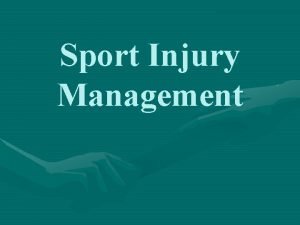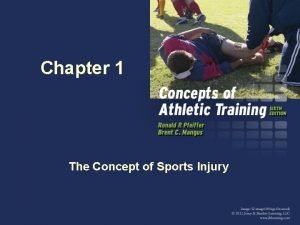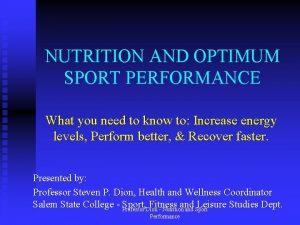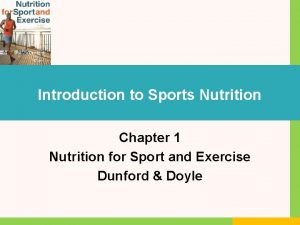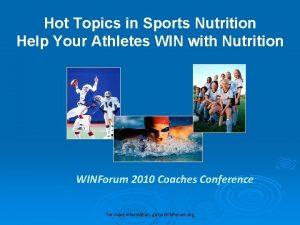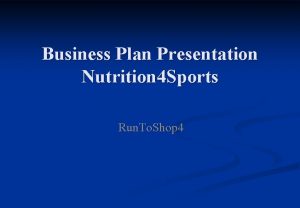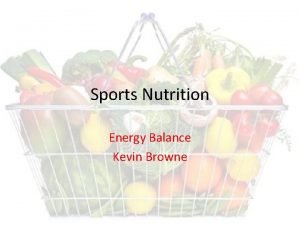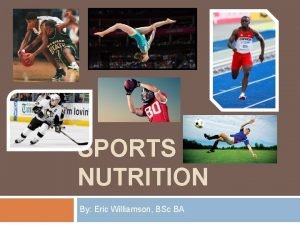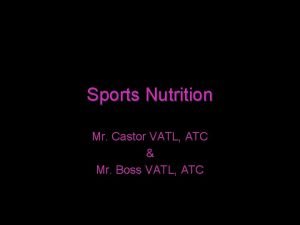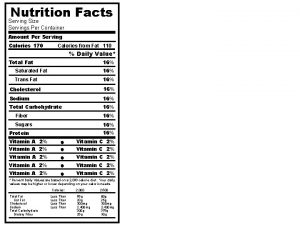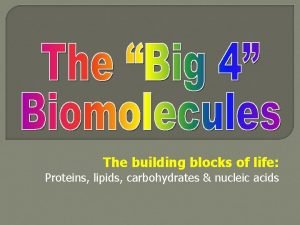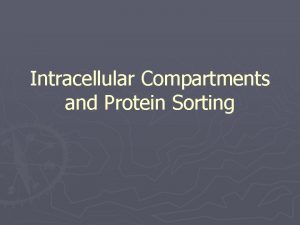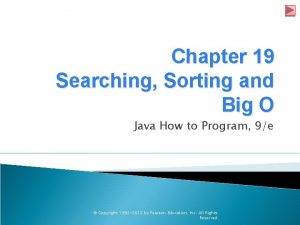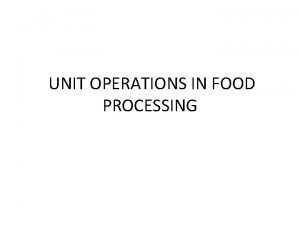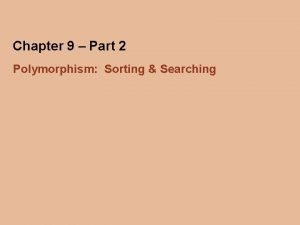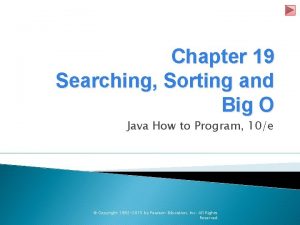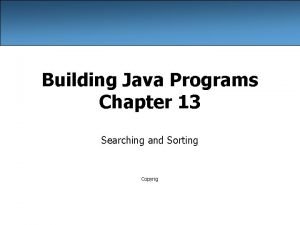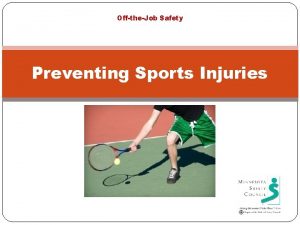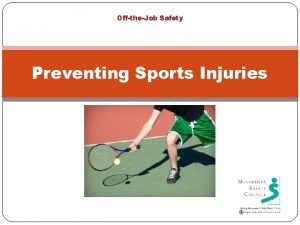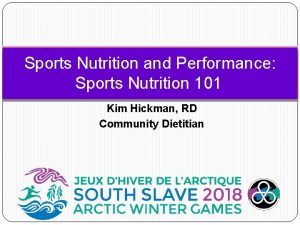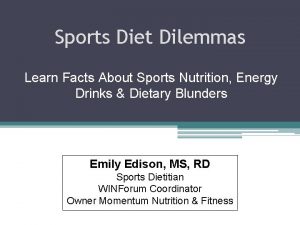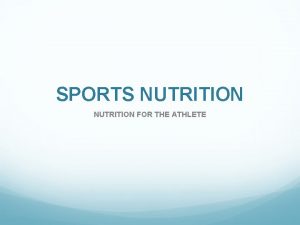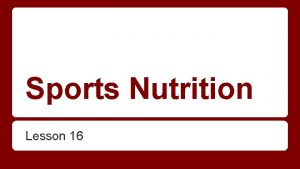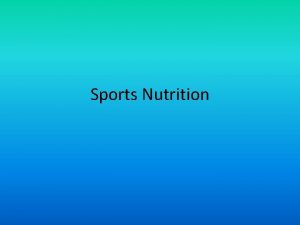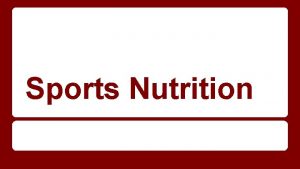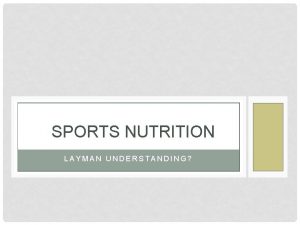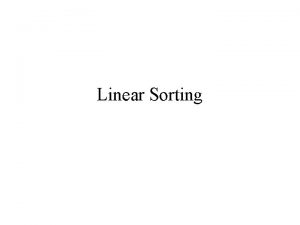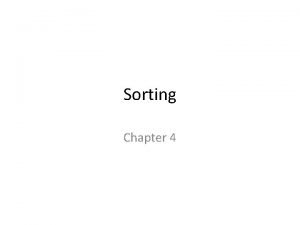Sports Injury and Nutrition Sorting Facts from Fantasy

































- Slides: 33

Sports Injury and Nutrition: Sorting Facts from Fantasy Roberta MS, RD/LD, CSSD, CDE, FAND Rice University Owls BCM-Dept of Orthopedic Surgery

The views contained in this presentation are mine unless otherwise noted Disclosure I have no financial disclosures or sponsorship for this presentation

Goals and Objectives Outline the physiological changes associated with the stress response Discuss the role of nutrition and exercise in the rehab of the injured athlete Describe the role of omega 3 fatty acids in concussion

Starvation and fuel use

Brain adaptation • Brain adapts to using ketones as a fuel- but not in the short run. • Ketoadaption starts at~ day 2 -5 depending on activity

Humans adapt to fuel deprivation • The process of keto-adaptation prevents the ongoing catabolism of lean mass to provide glucose • Down regulation of metabolic rate

Implications for sport nutrition • Underfueled athlete • Distance runners, wrestlers, ballerinas • Nutrition assessment and intervention • Hypothermia • Bradycardia • Urinary ketones • Increase in urine specific gravityketones increase specific gravity • Weight is one variable but not the only one

Changes in metabolic rate- starvation vs injury

Caring for the injured athlete- the ATC is the first line of defense Consider blunt trauma and concussions

Metabolism of Injured Patient Protein Metabolism: l. Nitrogen urine excretion 3050 g/day due to proteolysis; 20% utilized for energy (calories) the rest for gluconeogenesis by liver and kidney (cortisol, glucagon, catecholamine). l. Primary source of protein is the skeletal muscle and the visceral organs are spared. l. Injury can be viewed in two phases- immobilization and rehabilitation ( Tipton 2017)

Ketoadaptation is limited in injury l. Ketoadaptation is inhibited ----> gluconeogenesis persist ---> proteolysis persists = accelerated loss of lean mass l. The degree and duration of negative nitrogen balance is related to severity of injury. The net protein catabolism depends on the age, sex and physical condition of the patient • Immobility increases this loss • Consider the “cost” of returning this athlete to competition • Easy to weight restore an athlete, not easy to lean weight restore

Immobility: Metabolic Consequences CASCADE OF CHANGES LOSS MUSCLE MASS, STRENGTH, FUNCTION ↓MITOCHONDRIAL OXIDATIVE FUNCTION ↓ GLUCOSE DISPOSAL ↓BONE HEALTH: ↑ CALCIUM LOSS Wall, 2014

Fever increases calorie needs by 7% for each degree fever above 98. 6 Increases in BMR can range from an additional 10% to 100% depending on the type of injury Calorie needs during injury Organ injured also can dictate the amount of calories needed Appetite is worse secondary to pain and medications Metabolic rate peaks 3 -7 days after the injury

Body Composition should be done on all athletes BODPOD is preferable form of body composition Nutrition Assessment Preservation of lean weight occurs with proper nutrition and strength training For example, an injured athletes may have a lower body injury allowing some anabolic overload in upper body

BOD POD

Nutrition and the site of injury • Overall principles • Adequate protein • Energy management • Vitamin D • Omega 3 fatty acids • Anti-inflammatory diet • Bone injury • Calcium • Vitamin D • Soft tissue injury • Anti-inflammatory This Photo by Unknown Author is licensed under CC BY

Immobilization can reduce calorie needs • Limit high fat foods • No sweet drinks • Choose lean protein at each meal ~ 1 gram/pound • Reduce poor quality carbohydrates

Whey Protein & BCAA’s – Sources of Leucine Anti-catabolic amino acid May prevent catabolic damage associated with chronic inflammationcan stimulate MPS Decreased muscle proteolysis & markers of inflammation during eccentric exercise with BCAA’s and Taurine Ra, SG (2013) Journal of the International Society of Sports Nutrition 10: 51 -61

Which protein source is most effective? • Whey protein Isolate is the most effective In the majority of studies Found in milk and dietary supplements This Photo by Unknown Author is licensed under CC BY-NC-ND 19

Leucine activates m. TOR which is a metabolic signal for muscle protein synthesis Leucine drives muscle protein synthesis This Photo by Unknown Author is licensed under CC BY-SA-NC 20

Leucine – “The Rockstar AA” Source % Leucine Grams Needed Beef 8. 0 25 -36 Chicken 7. 5 27 -38 Pork 8. 0 25 -36 Egg 8. 6 23 -34 Fish 8. 1 25 -36 Whey 12. 0 17 -25 Milk 9. 8 20 -30 Wheat 6. 0 33 -50

Considerations for the sports medicine team • Injured athletes require medical nutritional therapy • Develop strategies for counteracting the stress response • Protein needs remain high at ~ 22. 5 grams/kg • Glutamine may become conditionally essential • Good results with Juven-HMB is a metabolite of leucine

Protein intake and weight management • 6 meta analysis examined protein intake and body fat loss • Percent of calories from protein ranged from 16%- 45% • Greater fat mass loss, greater weight loss and better maintenance of lean body mass • Excess protein is oxidized at not stored • Protein improves satiety and may contribute to better calorie control • Protein at each meal paired with a low glycemic index carbohydrate and an abundance of vegetables/fruit may be an optimal strategy 23

What do bones need? Calcium • Calcium. No good blood test except PTH • Calcium needs highest in puberty • The best sources are dairy: low fat milk, yogurt, cottage cheese, kefir and cheese • Other sources include canned salmon with bones, tofu, turnip greens, broccoli and kale • Some breakfast cereals have added calcium along with juices • Supplements no more than 500 mg This Photo by Unknown Author is licensed under CC BY-SA-NC

Vitamin D Deficiency common among athletes Receptors are found on cells with a nucleus Involved in transcription of >1000 genes Up-regulates anti-inflammatory cytokines; down-regulates proinflammatory

Bone health is also dependent on magnesium and vitamin K Magnesium is critical for cell development including osteo blasts and osteoclasts 60% of magnesium is found in bone This Photo by Unknown Author is licensed under CC BY-SA-NC Vitamin K requirements set based on amount need for blood coagulation and insufficient for bone Activation of osteocalcin- a bone formation protein Bone health is a great example of the synergy of nutrients This Photo by Unknown Author is licensed under CC BY-NC-ND

Creatine and brain function • Creatine can be considered a neuroprotectant • Study by Sullivan (2000) demonstrated that children who had a TBI and received. 4 gram/kg reported improvement in fatigue, dizziness and headaches • Patients with obstructive sleep apnea have a significant decrease in creatine which improves with CPAP • Those refusing to use CPAP have improvement in executive functioning with creatine This Photo by Unknown Author is licensed under CC BY-SA

Creatine and chronic illness This Photo by Unknown Author is licensed under CC BY-ND • The regeneration of phosphocreatine declines approximately 8% per decade after age 30 • The transport across the blood barrier is facilitated by a creatine transport protein • Creatine has been proposed as an adjunct to treatment in stroke, Huntington’s disease, Parkinson’s disease and concussion • The energy needs of the brain can be increased in neurodegenerative disease and this remains the plausible explanation of how creatine may be beneficial

Eccentric exercise is the lowering of the weight “braking action” of the muscle Eccentric exercise and the injured athlete Low energy cost – 4 - 5 times less than concentric exercise Slowing down the lowering phase can make the exercise harder Can be useful in restoring the lean weight lost in injry Trained PT, ATC and S&C Isner-Horobeti Sport s Medicine 2013 43: 483

Case study-sprinter with re-torn meniscus • Minor surgery • Immobility • Juven to minimize lean weight loss • Slow rep leg extension to activate muscle fibers • Ran 10 days after surgery which included an incision to remove scar tissue

Omega 3 fatty acids and MPS • Omega 3 fatty acids may sensitize the muscle cells to amino acids • Research by Wall, Morton and von Loon (2015) indicates an increase in strength • Two weeks of supplementation may be needed to modulate a decrease in lean body mass • Bleeding risk is minimal • Can be used as part of a soft tissue protocol

Concussion and TBI • Traumatic brain injury raises calorie/protein needs • Omega 3 fatty acids can produce antiinflammatory prostaglandins and cytokines • DHA promotes neuronal survival and neurogenesis • Lewis, et al have used high dose fish oil in the treatment and recovery from TBI • Diets with reduced omega 6 and elevated omega 3 in the prevention and management of concussions

The stress response prevents significant ketoadaptation Calorie and protein needs are elevated Summary Eccentric exercise may be indicated to promote muscle protein synthesis Increasing omega 3 and decreasing omega fatty acids may provide a treatment option
 External and internal sorting
External and internal sorting Battering intentional or unintentional
Battering intentional or unintentional Flipchart on safety practices and sports injury management
Flipchart on safety practices and sports injury management Sports injury definition
Sports injury definition Sports injury definition
Sports injury definition How do you find these activities
How do you find these activities Optimum sports performance
Optimum sports performance Basic nutrition principles
Basic nutrition principles Current topics in sports nutrition
Current topics in sports nutrition Sports nutrition business plan
Sports nutrition business plan Bmr sports nutrition
Bmr sports nutrition Eric sports nutrition
Eric sports nutrition Mr sport nutrition
Mr sport nutrition Monaco drink nutrition facts
Monaco drink nutrition facts Servings per container:
Servings per container: Carbohydrates
Carbohydrates Multiplication facts and division facts
Multiplication facts and division facts Recreation and sports elizabethan era
Recreation and sports elizabethan era Interesting facts about anne frank
Interesting facts about anne frank Dff network.com
Dff network.com Romeo and juliet fantasy overture analysis
Romeo and juliet fantasy overture analysis Difference between sorting and grading
Difference between sorting and grading Envelope nuclear
Envelope nuclear Compare between bubble sort and selection sort.
Compare between bubble sort and selection sort. Searching and sorting arrays in c++
Searching and sorting arrays in c++ Big o java
Big o java Restricting and sorting data in oracle
Restricting and sorting data in oracle Unit operations in food processing
Unit operations in food processing Lesson 2 assignment a sort of sorts answers
Lesson 2 assignment a sort of sorts answers Searching and sorting in java
Searching and sorting in java Searching and sorting java
Searching and sorting java Searching and sorting in java
Searching and sorting in java Physical and chemical properties sorting activity
Physical and chemical properties sorting activity Thai fantasy
Thai fantasy


